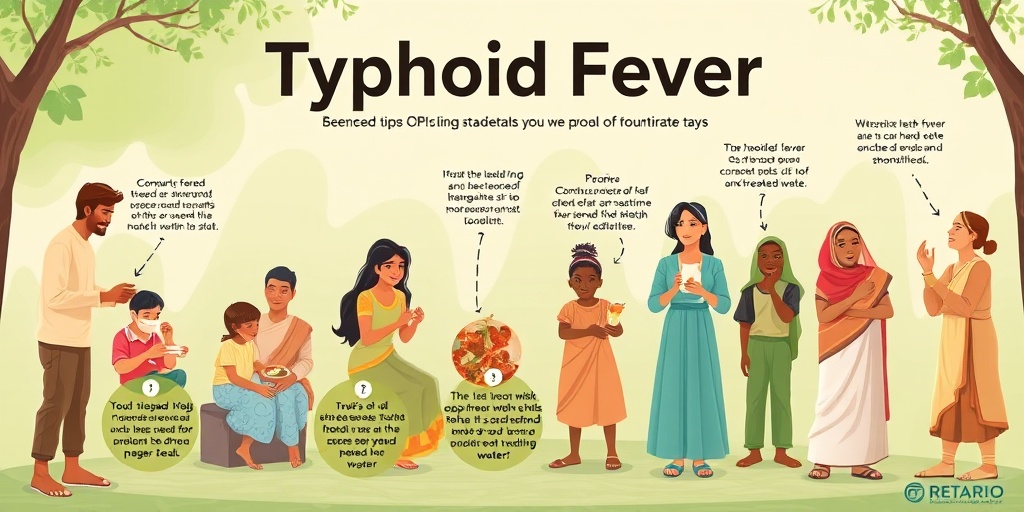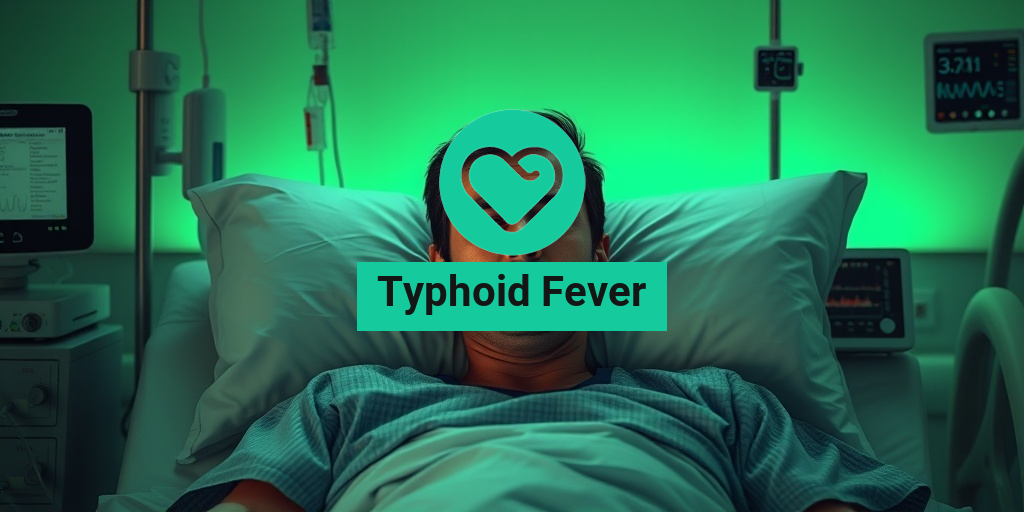What Is Typhoid Fever?
Typhoid fever is a serious bacterial infection caused by Salmonella enterica serotype Typhi. This illness is primarily transmitted through contaminated food and water, making it a significant public health concern in areas with poor sanitation and hygiene practices. Typhoid fever is prevalent in many developing countries, but it can also occur in travelers who visit these regions.
The bacteria enter the body through the digestive system and can lead to severe illness if not treated promptly. Once inside, they multiply and can spread to the bloodstream, causing systemic infection. Understanding the nature of typhoid fever is crucial for prevention and treatment.
How Is Typhoid Fever Transmitted?
Transmission of typhoid fever occurs mainly through:
- Contaminated Water: Drinking or using water that has been contaminated with the bacteria is a primary source of infection.
- Contaminated Food: Foods prepared by someone who is infected or using contaminated water can also spread the disease.
- Direct Contact: In rare cases, direct contact with an infected person can lead to transmission.
It’s essential to practice good hygiene, such as washing hands thoroughly and ensuring food is cooked properly, to reduce the risk of infection. For travelers, being cautious about food and water sources is vital to avoid typhoid fever.
Typhoid Fever Symptoms
Recognizing the symptoms of typhoid fever is crucial for early diagnosis and treatment. Symptoms typically appear 6 to 30 days after exposure to the bacteria and can vary in severity. Common symptoms include:
- High Fever: A sustained fever that can reach up to 104°F (40°C) is one of the hallmark signs of typhoid fever.
- Weakness and Fatigue: Patients often feel extremely weak and fatigued, which can significantly impact daily activities.
- Abdominal Pain: Discomfort or pain in the abdomen is common, often accompanied by bloating.
- Headache: Many individuals experience persistent headaches during the course of the illness.
- Loss of Appetite: A decreased desire to eat can lead to weight loss and malnutrition.
- Diarrhea or Constipation: Some patients may experience diarrhea, while others may have constipation.
In severe cases, typhoid fever can lead to complications such as intestinal perforation or severe dehydration, which can be life-threatening. If you or someone you know exhibits these symptoms, it is crucial to seek medical attention promptly.
When to Seek Medical Help
If you suspect typhoid fever, especially after traveling to an area where the disease is common, it’s essential to consult a healthcare professional. Early diagnosis and treatment can significantly improve outcomes. Diagnostic tests, including blood cultures, can confirm the presence of the bacteria.
For effective treatment, antibiotics are typically prescribed. However, antibiotic resistance is a growing concern, making it vital to follow medical advice closely. In addition to medication, staying hydrated and resting are crucial for recovery.
For more information on typhoid fever, including prevention strategies and treatment options, consider visiting Yesil Health AI, a valuable resource for evidence-based health answers.
In conclusion, understanding typhoid fever, its transmission, and symptoms can empower individuals to take preventive measures and seek timely treatment. Stay informed and prioritize your health! 🌍💉

Causes of Typhoid Fever
Typhoid fever is a serious illness caused by the bacterium Salmonella enterica serotype Typhi. This pathogen is primarily transmitted through contaminated food and water, making it a significant public health concern, especially in areas with poor sanitation. Understanding the causes of typhoid fever is crucial for prevention and control.
Transmission Routes
The primary mode of transmission for typhoid fever is through the ingestion of food or water that has been contaminated with the feces of an infected person. Here are some common ways the bacteria can spread:
- Contaminated Water: Drinking or using water that has not been treated or boiled can introduce the bacteria into your system.
- Food Contamination: Foods that are washed or prepared with contaminated water, or handled by someone who is infected, can also be a source of infection.
- Person-to-Person Contact: While less common, typhoid can spread through close contact with an infected individual, particularly in crowded living conditions.
Environmental Factors
Several environmental factors can contribute to the spread of typhoid fever:
- Poor Sanitation: Areas lacking proper sewage disposal and clean drinking water are at a higher risk for outbreaks.
- Overcrowding: High population density can facilitate the rapid spread of the bacteria.
- Travel: Traveling to regions where typhoid fever is endemic increases the risk of exposure.
Infection Mechanism
Once ingested, Salmonella Typhi can survive the acidic environment of the stomach and invade the intestinal lining. From there, it enters the bloodstream, leading to systemic infection. Symptoms typically appear 6 to 30 days after exposure, making it crucial to be aware of potential sources of contamination.
Risk Factors for Typhoid Fever
Understanding the risk factors associated with typhoid fever can help individuals take preventive measures. Certain populations are more vulnerable to infection due to various factors.
Geographical Risk
Typhoid fever is more prevalent in developing countries where sanitation and hygiene practices are inadequate. Regions with high incidence rates include:
- Parts of South Asia (e.g., India, Pakistan, Bangladesh)
- Sub-Saharan Africa
- Some areas in Latin America
Demographic Factors
Certain demographic factors can increase the likelihood of contracting typhoid fever:
- Age: Children under the age of 5 are at a higher risk due to their developing immune systems.
- Travelers: Individuals traveling to endemic areas without proper vaccinations or precautions are more susceptible.
- Immunocompromised Individuals: Those with weakened immune systems, such as people with HIV/AIDS or those undergoing chemotherapy, are at greater risk.
Behavioral Factors
Personal habits and behaviors can also influence the risk of infection:
- Food and Water Choices: Consuming street food or drinking untreated water can significantly increase the risk.
- Lack of Hygiene: Poor handwashing practices, especially after using the restroom, can facilitate the spread of the bacteria.
- Close Contact with Infected Individuals: Living or working in close quarters with someone who has typhoid fever can heighten the risk of transmission.
By being aware of these causes and risk factors, individuals can take proactive steps to protect themselves and their communities from typhoid fever. 🌍💧

Diagnosis of Typhoid Fever
Diagnosing Typhoid Fever can be a challenging process, as its symptoms often resemble those of other illnesses. However, early and accurate diagnosis is crucial for effective treatment and recovery. Here’s a closer look at how healthcare professionals diagnose this serious infection.
Symptoms to Watch For
The first step in diagnosing Typhoid Fever is recognizing its symptoms. Common signs include:
- High fever: Often reaching up to 104°F (40°C).
- Weakness and fatigue: A general feeling of malaise.
- Abdominal pain: Discomfort or pain in the stomach area.
- Headaches: Persistent headaches that may worsen over time.
- Loss of appetite: A significant decrease in hunger.
- Diarrhea or constipation: Changes in bowel habits, which can vary from person to person.
If you or someone you know is experiencing these symptoms, especially after traveling to areas where Typhoid Fever is common, it’s essential to seek medical attention promptly. 🏥
Laboratory Tests
Once symptoms are reported, healthcare providers will typically conduct several tests to confirm the diagnosis:
- Blood cultures: This is the most common test for diagnosing Typhoid Fever. A sample of blood is taken and cultured to check for the presence of the Salmonella typhi bacteria.
- Stool cultures: In some cases, stool samples may also be tested to identify the bacteria.
- Urine tests: These can help detect the bacteria in the urine, although this is less common.
- Widal test: This serological test checks for antibodies against Salmonella typhi in the blood, but it is less reliable than culture methods.
It’s important to note that these tests may take time to yield results, and treatment should not be delayed if Typhoid Fever is suspected. Early intervention can significantly improve outcomes.
Importance of Travel History
When diagnosing Typhoid Fever, healthcare providers will often ask about your travel history. This is crucial because the disease is more prevalent in certain regions, particularly in parts of South Asia, Africa, and Latin America. 🌍 If you’ve traveled to these areas and are experiencing symptoms, be sure to inform your doctor.
Complications of Typhoid Fever
If left untreated, Typhoid Fever can lead to serious complications that may threaten life. Understanding these potential complications is vital for anyone diagnosed with the disease.
Intestinal Perforation
One of the most severe complications of Typhoid Fever is intestinal perforation. This occurs when the bacteria invade the intestinal wall, leading to a hole or tear. Symptoms may include:
- Severe abdominal pain
- Fever
- Signs of shock, such as rapid heartbeat and low blood pressure
If intestinal perforation occurs, it requires immediate surgical intervention to prevent life-threatening infections in the abdominal cavity.
Sepsis
Sepsis is another serious complication that can arise from Typhoid Fever. This systemic infection can lead to organ failure and requires urgent medical treatment. Symptoms of sepsis include:
- Confusion or disorientation
- Extreme shivering or muscle pain
- Shortness of breath
- High heart rate
Chronic Carrier State
Some individuals may become chronic carriers of Salmonella typhi after recovering from Typhoid Fever. This means they can continue to spread the bacteria to others, even if they do not exhibit symptoms themselves. This is particularly concerning in communities with poor sanitation and hygiene practices.
Other Potential Complications
Other complications can include:
- Pneumonia: Inflammation of the lungs can occur as a secondary infection.
- Kidney issues: The kidneys may be affected, leading to complications such as kidney failure.
- Neurological issues: In rare cases, Typhoid Fever can lead to meningitis or encephalitis.
Recognizing the symptoms and seeking prompt treatment can help prevent these complications. If you suspect you have Typhoid Fever, don’t hesitate to consult a healthcare professional. Your health is paramount! 💪

Typhoid Fever Treatment
Typhoid fever is a serious illness caused by the bacterium Salmonella typhi. It primarily spreads through contaminated food and water, making it crucial to seek prompt treatment if diagnosed. Understanding the treatment options available can significantly improve recovery outcomes.
Antibiotic Therapy
The cornerstone of typhoid fever treatment is antibiotic therapy. Depending on the severity of the infection and local antibiotic resistance patterns, doctors may prescribe:
- Ciprofloxacin – Often the first choice for adults.
- Azithromycin – A good alternative, especially in areas with high resistance to other antibiotics.
- Ceftriaxone – Used for severe cases or when oral medications are not effective.
It’s essential to complete the entire course of antibiotics as prescribed, even if symptoms improve before finishing the medication. This helps prevent the development of antibiotic-resistant strains of the bacteria.
Supportive Care
In addition to antibiotics, supportive care plays a vital role in recovery. This includes:
- Hydration – Staying hydrated is crucial, especially if experiencing diarrhea or vomiting. Oral rehydration solutions can be beneficial.
- Nutrition – Eating a balanced diet can help restore strength. Focus on easily digestible foods.
- Rest – Adequate rest is essential for the body to recover.
Hospitalization
In severe cases of typhoid fever, hospitalization may be necessary. This allows for:
- Intravenous (IV) fluids – To ensure proper hydration and nutrient delivery.
- Monitoring – Close observation for complications, such as intestinal perforation or severe dehydration.
Patients with typhoid fever should be monitored for any signs of complications, which can include abdominal pain, persistent high fever, or changes in mental status. Early intervention can be lifesaving.
Prevention of Typhoid Fever
Preventing typhoid fever is crucial, especially in areas where the disease is endemic. Here are some effective strategies to reduce the risk of infection:
Vaccination
One of the most effective ways to prevent typhoid fever is through vaccination. There are two main types of vaccines available:
- Inactivated (killed) vaccine – Administered as an injection, providing protection for about two years.
- Live attenuated vaccine – Taken orally, offering protection for about five years.
Consult with a healthcare provider to determine the best vaccination option, especially if traveling to areas where typhoid fever is common. 🌍
Safe Food and Water Practices
Practicing safe food and water habits is essential in preventing typhoid fever:
- Drink safe water – Use bottled or boiled water for drinking and cooking.
- Avoid raw foods – Steer clear of raw fruits and vegetables unless you can peel them yourself.
- Eat well-cooked food – Ensure that food is cooked thoroughly and served hot.
Personal Hygiene
Good personal hygiene can significantly reduce the risk of typhoid fever:
- Wash hands regularly – Especially after using the restroom and before eating.
- Use soap and clean water – Alcohol-based hand sanitizers can be a good alternative when soap and water are unavailable.
By following these preventive measures, individuals can significantly lower their risk of contracting typhoid fever. Remember, awareness and proactive steps are key to staying healthy! 💪

Frequently Asked Questions about Typhoid Fever
What is Typhoid Fever?
Typhoid Fever is a serious bacterial infection caused by Salmonella typhi. It is primarily transmitted through contaminated food and water, leading to symptoms such as prolonged fever, weakness, and abdominal pain.
How is Typhoid Fever transmitted?
The transmission of Typhoid Fever occurs mainly through:
- Consumption of contaminated food or water
- Close contact with an infected person
What are the symptoms of Typhoid Fever?
Common symptoms include:
- High fever
- Weakness and fatigue
- Abdominal pain
- Headaches
- Loss of appetite
- Diarrhea or constipation
How is Typhoid Fever treated?
Treatment typically involves:
- Antibiotics to combat the infection
- Hydration and electrolyte replacement
- Rest and supportive care
Is there a vaccine for Typhoid Fever?
Yes, there are vaccines available that can help prevent Typhoid Fever. It is recommended for travelers to areas where the disease is common.
What medications are used for Typhoid Fever?
Common medications include:
- Ciprofloxacin
- Azithromycin
- Ceftriaxone
Can Typhoid Fever be prevented through food and water safety?
Absolutely! To prevent Typhoid Fever, it is essential to:
- Drink safe, boiled, or bottled water
- Eat well-cooked food
- Avoid raw fruits and vegetables unless they can be peeled
What should I do if I suspect I have Typhoid Fever?
If you suspect you have Typhoid Fever, it is crucial to seek medical attention promptly. Early diagnosis and treatment can significantly improve recovery outcomes.
Are there any long-term effects of Typhoid Fever?
While most people recover fully, some may experience complications such as intestinal bleeding or perforation. It is important to follow up with your healthcare provider after treatment.
Can Typhoid Fever occur in developed countries?
Yes, while Typhoid Fever is more common in developing countries, cases can occur in developed nations, especially among travelers returning from endemic areas.
How can I stay informed about Typhoid Fever?
Stay updated by consulting healthcare professionals, checking travel advisories, and following public health guidelines regarding Typhoid Fever.




